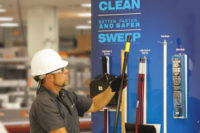Defining personalization
Employers and employees are familiar with OSHA signage that features a bold header stating the degree of the hazard, followed by a succinct warning statement. In many cases, the law requires these signs to be posted.
Personalized facility identification is not intended to belittle the importance of required signage but rather to enhance it by raising awareness and attracting attention.
When employees grow accustomed to seeing something, they often take it for granted. Aside from signage, fire extinguishers are a good example. Employees walk by them every day not paying attention to which one is closest to their workspace. Sometimes, standard safety signs become like fire extinguishers. They blend in and often go unnoticed.
For this reason, highly visual, personalized solutions have the opportunity to make a real impact. Whether signage, scoreboards, banners or posters, personalized signs and identification products attract employee notice and provide the platform for communicating company pride and ownership, personal accountability, safety awareness and more.
Case Study: Shamrock Farms
Does personalization work or is it nothing more than a fleeting fad?
Shamrock Farms is a family-owned business and the 7th largest food distributor in the U.S. Their top concern is not only the quality of the dairy products they produce, but also the safety of the workers they employ. In 2010, they had eight employees who experienced chemical injuries, despite safety signage being posted.
As a result, Shamrock Farms’ management implemented a more visual workplace with an emphasis on improved signage to identify procedures and expectations. They introduced 5S product solutions (such as shadow boards) and incorporated image-centered, cross-cultural signs to foster ease of understanding among their bilingual workforce. In addition, they invested in personalized signs. Specifically, they targeted fogging signs that notify employees when routine fogging or cleaning takes place.
For example, a bright yellow sign with black print communicated “CAUTION: FOGGING IN PROCESS.” Then they took the signage a step farther and added their logo showing Roxie the Cow, their company mascot, wearing a respirator to visualize the hazard.
Shamrock Farms, explained that the point is to make employees take notice and ask themselves why Roxie is wearing a respirator. In addition to personalizing this sign, they wanted to do something that would make readers stop and take that extra second to pay attention to it.
The company has experienced positive results from their intuitive signage investment.
See the difference
In the case of Shamrock Farms, the results speak to higher performance and achievement. On the flip side, the impact of personalization may reflect what does not happen. For example, closer attention to safety and procedures may result in fewer accidents and mistakes.
Demands and distractions constantly vie for employee attention in fast-paced workplaces where productivity and efficiency are a must. Personalization transforms otherwise ordinary signs into highly visible, recognizable and relatable platforms that speak to employees.

